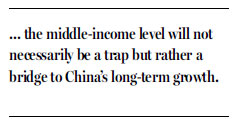The authorities' latest call for efforts to expand the middle-income group is much needed, because China's sustainable growth in the long run is dependent on the formation of a significantly larger middle-income group who will increase consumption and reward supply-side reforms that best serve their needs.
At a meeting of the Central Leading Group for Financial and Economic Affairs on Monday, President Xi Jinping particularly stressed efforts to expand the middle-income group and improve the income distribution mechanism.
This newly-found sense of urgency to further increase the number of middle-income workers is surely related to the role that consumption is now playing in ensuring the stable, moderate growth of the world's second-largest economy.
The latest statistics show that final consumption contributed 84.7 percent of China's economic growth in the first quarter while capital investments' contribution came in at 35.8 percent and net exports of goods and services dragged growth down by 20.5 percent. The consumption share marked a significant jump from the 66.4-percent ratio at the end of 2015.
Although China's economy expanded by only 6.7 percent year-on-year in the first quarter of 2016, the slowest since early 2009, indicating considerably strong headwinds, it is fairly reassuring, if not surprising, to see the rapid rise of consumption as a leading growth engine while traditional growth drivers such as investment and exports are losing steam.
Since all the domestic measures to address overcapacity in many traditional industrial sectors will take time to bear fruit and the global trade will not regain its growth momentum any time soon as the world economy struggles under international financial and political uncertainties, it is reasonable for Chinese policymakers to double down on stronger consumption-led growth to avoid an unexpected hard landing.
Recently, there has been talk of China's economy tending towards L-shaped growth as deep-rooted problems persist and new challenges emerge, including shrinking private investment, the real estate bubble, industrial overcapacity, non-performing loans, local government debt and financial market risk.
By ruling out the possibility of a quick and strong recovery, such a sober view has actually raised the question of how the country can manage to overcome the middle-income trap after more than three decades of double digit growth.
While rising income levels have eroded the international competitiveness of many small- and mid-sized economies to slow their growth, a significantly enlarged middle-income group might be the Chinese answer to this global development challenge.
In spite of the lack of a clearly-defined criterion for middle income in this country, the fact that Chinese travelers have made around 120 million overseas trips in 2015, up 12 percent from the year before, will at least provide a glance at the huge potential of a certain part of the country's middle-income group.
With a population of 1.3 billion, no one should expect the number of global-trotters from China to peak soon as the country's middle-income group is just set to expand.
Instead of regarding rising income levels for a larger number of Chinese workers as merely a burden on enterprises in this country, Chinese policymakers should realize that a better income distribution mechanism to ensure a larger share of the overall economic pie for the majority of workers will help sustain economic growth in the long run.
On one hand, a substantial increase in the number of middle-income families will give a lasting and powerful boost to consumption-led growth. On the other hand, upgrading their consumption will incentivize Chinese enterprises to embrace supply-side reforms on which China's economic future hinges.
In this sense, the middle-income level will not necessarily be a trap but rather a bridge to China's long-term growth.
The author is a senior writer with China Daily.

(China Daily 05/19/2016 page9)
